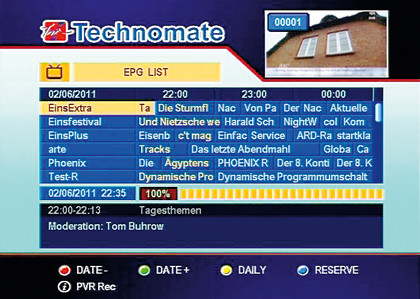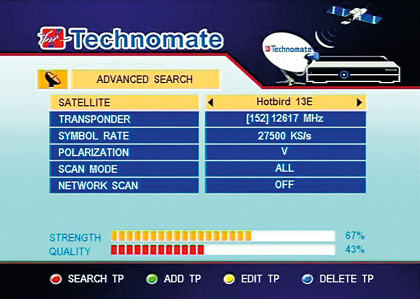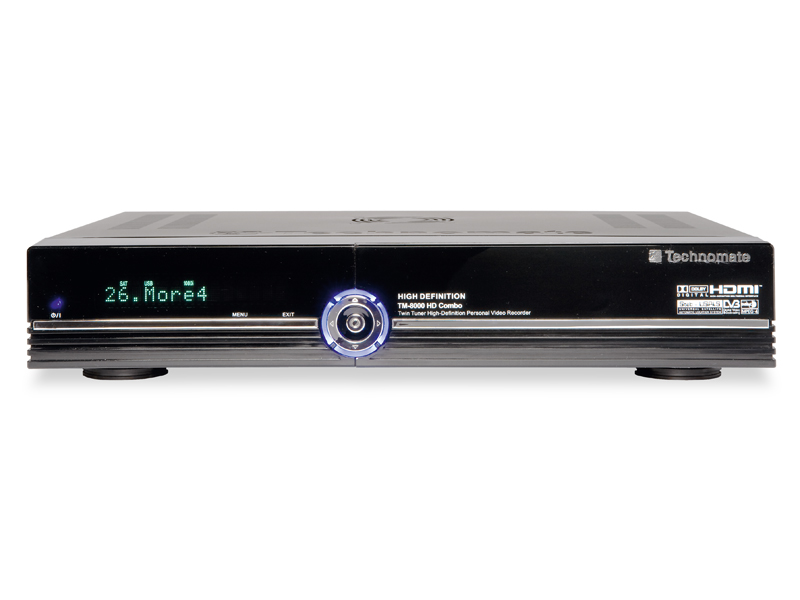TechRadar Verdict
Pros
- +
Removable HDD
- +
Strong AV performance
- +
Blind search
Cons
- -
Networking underutilised
- -
Only JPEG and MP3 currently supported by media player
- -
Minor bugs
Why you can trust TechRadar
For those who remain undecided between terrestrial and satellite, we present the TM-8000 HD Combo from Technomate. This smart-looking unit, which has a top-mounted cooling fan, includes both satellite and terrestrial tuners.
It can be upgraded to full PVR operation, by inserting a 2.5-inch SATA hard drive into a slot that's hidden behind a front-panel flap. A neat idea, it has to be said.
However, although the satellite tuner (and the receiver itself) is capable of tuning into hi-def channels, courtesy of its DVB-S2 compatibility, the same is not true of its terrestrial counterpart. This caters only for the DVB-T standard, and so the hi-def channels are overlooked.
The TM-8000 HD Combo really comes into its own when you have both types of antenna connected – with the HDD installed you'll be able to record one while watching another. The receiver caters for multi-satellite and with the appropriate outside hardware you'll be able to expand your viewing choice (which includes some European HD transmissions).
Other useful features include blind search, provision for pay-TV upgrades, a multimedia player, integrated networking and – that rarest of things – a UHF modulator.
Appearance and connectivity
A centrally mounted LED cluster on the glossy frontpanel punctuates the centrally mounted joypad, which is used to change volume level or step through channels. Menu and exit buttons allow basic configuration parameters to be accessed too.
Sign up for breaking news, reviews, opinion, top tech deals, and more.
The comprehensive fluorescent display is an unexpected delight in these days of cost-cutting. On the opposite side of the front panel is a flap that conceals the aforementioned HDD compartment, a USB port and the conditional access hardware, which consists of a card-reader and two CI slots.

The HDD is a fairly tight fit, and it's perhaps just as well that our Technomate-fitted HDD boasted a tab for removal – even with the finger recesses removal would be quite tricky without it.
Rear-panel connectivity is comprehensive. Both the terrestrial and LNB feeds benefit from loopthrough facilities. Taking the form of an additional loopthrough facility, the UHF modulator is useful, as it would allow off-air services and received channels alike to be distributed around the house via UHF.
Your main TV can be hooked up via HDMI (up to 1080i), component, RGB/composite Scart or S-video. HDMI and a standard-def output can be active simultaneously, a useful feature for those with complex multi-room AV setups.

Among the data connections are a second USB port, RS232, e-SATA (for external HDDs) and Ethernet. Sadly, Technomate hasn't yet done anything meaningful with the latter. All you can do for now is access firmware updates and update channel lists.
Setup
Among a plethora of menus is 'installation' where you'll find a series of submenus covering dish setup and terrestrial/satellite scanning. For each of the desired satellites, you can specify a transponder (its signal and quality are displayed in bar graph form), LNB power setting and DiSEqC 1.0/1.1 switch-position.
A simple 'all-and/or-free' search can then be invoked – additional refinements include network and radio specific scans. This should suffice for most situations, however, 'advanced search' is also provided. From here, you can choose one of the target satellite's preset transponders. These can be edited or added to; polarity, search type, network scanning and symbol rate are all changeable.
For some reason the ability to specify PIDs is not provided, although the channel editor will let you modify the PIDs of existing channels.
It may be slower than a regular search, but the blind search facility will be of particular enthusiast appeal. The feature seeks out new transponders and then scans these for new channels. Step size can be changed, allowing you to trade off resolution (and thus channel-finding potential) against the time taken.
DTT channels are the responsibility of a 'terrestrial scan' menu. From here, a single channel or the entire band can be scanned. Menu options are provided for bandwidth and channel type (free and/or encrypted).
The 'motorised setup' menu supports both DiSEqC 1.2 and USALS mounts. Coarse and fine movement steps are off ered for 1.2 dish peaking in USALS mode. As with some previous Technomates, a handy feature known as 'auto-navigation' will scan a user-specified group of satellites in succession, the dish moving as appropriate.
From the 'edit channels' menu, services can be moved, locked, skipped, deleted or added. You can also place frequently viewed channels into one of eight lists.
Basic use
The formidable-looking handset includes 'shortcut' buttons for DiSEqC movement, the recording list and channel editing. As with previous Technomate receivers, we note an annoying tendency to 'overshoot' past the desired option. But in other respects, it's excellent.
As is usual, the channel list – which can be sorted alphabetically, by transponder or encryption type – is accessed by pressing 'OK'. When viewing a channel, the 'info' button releases EPG-derived information about the current programme. Pressing the coloured buttons reveals tech data.

The EPG supports now-and-next as well as seven-day DVB schedules for terrestrial and satellite channels alike. Up to six consecutive channels can be displayed simultaneously, and navigating the schedules is a matter of using the joypad.
Programming the 16-event timer, which supports weekly and daily recording, is also simple. Other features include a multi-channel 'mosaic', an effective picture zoom, a shortcut button to video/aspect ratio/resolution adjustments and a sleep timer; no game-type gimmicks are provided.
However, the DTT tuner could be improved. It lacks support for the both the UK-spec digital teletext (MHEG-5) and DVB subtitles. The subtitles button of the review sample didn't work at all. If you need the facility with British TV channels, you're advised to view via satellite and select page 888 on 'regular' teletext. Audio description is supported.
PVR and multimedia

An irritating camcorder-style 'rec' graphic flashes onscreen whenever a recording is in progress, and there's no means of removing it. Another minor annoyance is that it takes a minute or so for the HDD to initialise after startup and recordings cannot be started until this procedure has completed.
In other respects recording is more flexible. In addition to EPG scheduling, recordings can be manually invoked. You can also modify or enter timer parameters yourself – a moot point for late-running schedules or Freesat-type channels; as far as boxes like this are concerned, the only available (now-and-next) EPG data is of limited value.
There may only be one satellite tuner, but you can record one channel while watching another provided they're carried on the same transponder (or multiplex for DTT). In fact, it's possible to simultaneously record two channels while a third is onscreen or, for that matter, while you're playing an existing recording. A 'file list' button lists and presents for selection all such content.
Buy a cradle-type SATA docking station and plug your FAT32-formatted hard drive into it. Stored recordings can then be transferred at much-faster-than-Ethernet speeds. What a pity that only MP3s and JPEG playback is also supported (more formats are promised 'soon').
MPEG files with the same technical parameters as standard-definition TV broadcasts aren't even listed, and thus cannot be played. We hope that new firmware will accommodate other formats, such as DivX/XviD/mkv video.
Timeshifting is possible and additional 'trick play' features are 'bookmarks', variable-speed cue/review, 'skip' playback and slow motion.
Performance

Searching is reasonably quick, a hunt of 100 Hot Bird transponders being completed within four minutes. Blind search is thorough yet speedy – even with the smallest (and default) 1MHz step size, a full Hot Bird scan was completed in under 10 minutes. We suspect that blind search is implemented in hardware, rather than software alone.
Even with a fairly small dish, all of the key Astra 1x and Hot Bird services were reliably received; the sensitivity of the DTT tuner proved to be fine too. HDMI picture quality from the satellite-delivered BBC channels and ITV1 HD, on a 1080p Samsung LCD TV, was excellent.
Positive characteristics include abundant detail and pristine colour fidelity. What a pity that we couldn't compare them with the terrestrial HD simulcasts, owing to the lack of DVB-T2 support.
Decent standard-def content, from satellite and terrestrial sources alike, also fared well with no unpleasant upscaling anomalies. Scart and component performed well, and the S-video output – used to source the screenshots accompanying this review – was appreciated too.
TV sound quality was excellent, although radio was hampered by occasional 'glitches'. We recorded the radio programme in question; its transport stream, found to be error-free, played on a PC just fine.
Verdict
In many respects this is a solid performer with flexible recording facilities and a host of worthwhile features. In particular, the removable HDD will appeal to those who have a need to get recordings onto a PC.
But some minor issues need addressing – like the non-functional DVB subtitling and flashing 'rec' indicator. We would also like Technomate to make more of the Ethernet port, and bolster the multimedia player format as promised.
Follow TechRadar Reviews on Twitter: http://twitter.com/techradarreview
